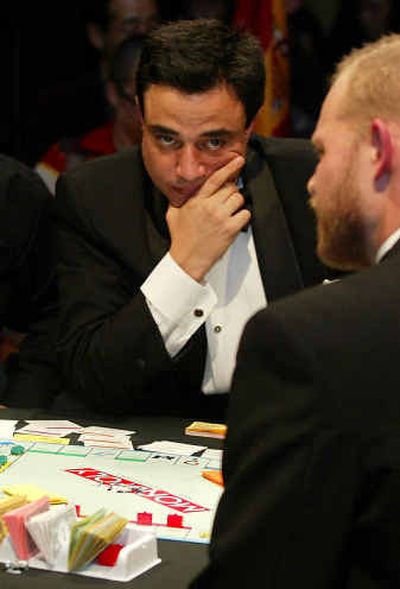Dice roll decisive in Monopoly

TOKYO – A Spanish lab technician needed only two hours to amass a small real estate fortune and drive a Norwegian mutual fund manager’s railroad empire into bankruptcy to capture the World Monopoly Championship on Saturday.
Antonio Zafra Fernandez, 36, of Madrid pumped his fist in the air after he bested Norwegian Bjorn Andenaes of Oslo in the game to take home the $15,140 prize – equal to the amount of play money in a Monopoly set.
“I’m extremely happy and so proud,” Fernandez said after hoisting a giant winner’s check in the air. He said he and his wife would spend the prize money on a new car, but added: “It’s not about the money. I’m going home as a champion, which doesn’t happen often in a person’s life.”
Andenaes, who had worn his Rocky Balboa boxer shorts in training and prepared by memorizing endgame probabilities from a study guide on the Internet, did not have the luck of the dice in the end.
“Luck was the deciding factor,” said Phil Orbanes, the tournament’s chief judge from the United States.
The companies that sell Monopoly around the world flew players from 38 nations to the Japanese capital for the two-day event, first held in 1973 in Washington.
The four finalists, all dressed in tuxedos, competed Saturday while a Mr. Monopoly – decked out in a silver mustache, top hat and cane – hovered near the stage. A real banker managed the tournament’s money.
Invented in 1934 by Germantown, Pa.-native Charles B. Darrow, Monopoly is now sold in 80 countries and 26 languages.
International editions use the same format as the original sold in the United States, but local currencies and street names are used. In the U.S. edition, the priciest street is the Boardwalk. In England, the spot is occupied by Mayfair, and in France, it’s Rue de la Paix.
The championship used the U.S. version.
Each player starts with $1,500 and must try to earn more by buying famous streets, putting up housing on them and charging rent to players that land on them. The game ends when all but one player has gone bust.
Fernandez got an early break when he landed on New York Avenue, Tennessee Avenue and St. James Place and snapped up the key streets that tend to yield the highest profits. Two other finalists, Bartlomiej Korczak, 21, of Tarnow, Poland, and 36-year-old Anthony Redmond of Dublin, Ireland, were soon insolvent.
Andenaes struggled to catch up after Fernandez’s buying spree. But his fate was sealed when he rolled an unlucky six, moved his wheelbarrow to Tennessee Avenue and lost his shirt.
With TV cameras rolling and a translator at his elbow, Fernandez asked Andenaes for $950 rent for the hotels on Tennessee Avenue.
Andenaes, who owned the four railroad lines but was short on cash, conceded. Fernandez hopped out of his seat, pumped his fists and beamed.
The Spaniard said he “played to win” but didn’t stick to a strategy.
Meanwhile, Andenaes did not try to hide his disappointment.
“I was just throwing the dice,” he said. “Second sounds great but it’s so far from being champion.”
Orbanes, the judge and the author of the “The Monopoly Companion,” said all of the players in the championship understand how to win at the game, so it really comes down to a roll of the dice.
“It’s like real life: So much of your success depends on how well you get along with the other players and how good you are at persuading them to do something that’s in your best interest but not theirs, ” he said.